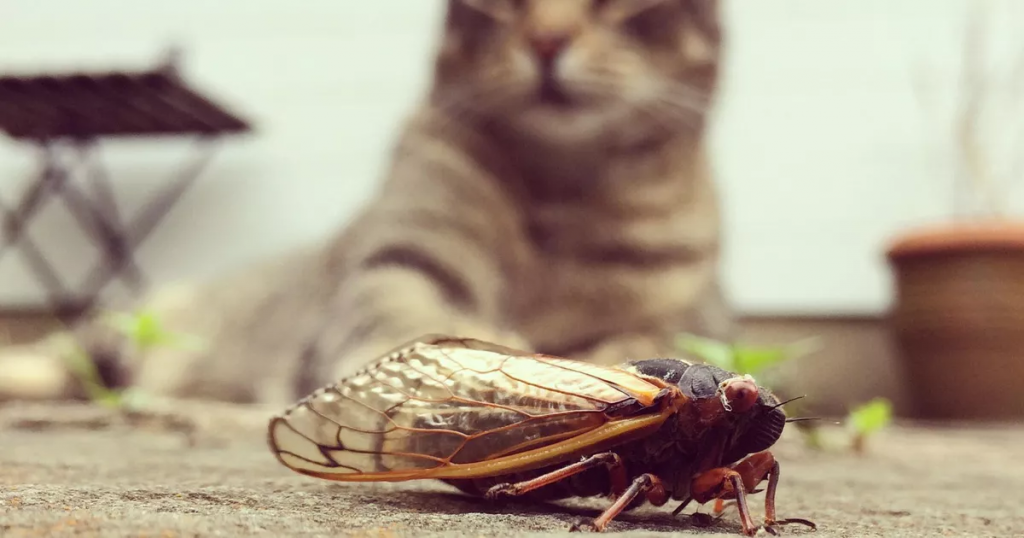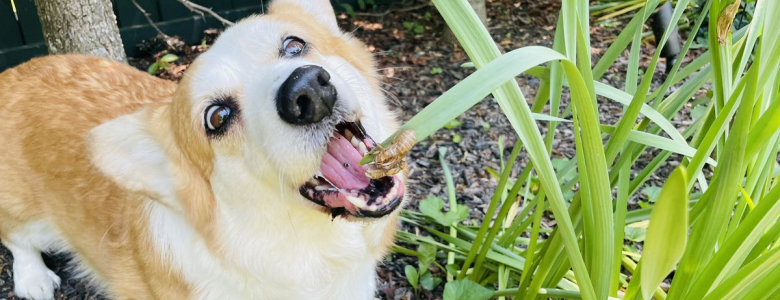
They’re here. We see them everywhere, hear them screaming in the trees, and can’t seem to convince our pets they’re disgusting: Brood X Cicadas.
The cicadas emerging now are periodical insects. They spend most of their lives underground feeding on tree roots, before tunneling to the surface to look for mates in the eastern U.S.. This year’s insects all live on 17-year cycles and luckily, after another month, will slowly either die off or dig back down into the ground to await a new season.
Your dog may have sensed this incoming change. Many owners report their pups digging in the yard excessively and being a little nervous when outside compared to normal. This is because your pup heard the cicadas digging towards the surface. I, for one, am glad I didn’t hear this part of their arrival as it sounds terrifying.
The good news is cicadas aren’t poisonous to your pets. HOWEVER, you should still limit your pet’s consumption. There are many other issues that could be caused by over-eating these insects.
- Exoskeletons: Cicadas shed an outer hard shell after they emerge. This shell is very hard and can shatter upon digestion. This makes it hard to digest and can cause a blockage in your pet’s GI tract.
- Pesticides/Parasites: In anticipating the increase of cicadas, a lot of lawn owners heavily sprayed pesticides. These sprays may have killed the bugs when they reached the surface, but left them laying around coated in poison. The same goes for any parasites the cicadas may have contracted/brought up with them. Eating these foreign substances is dangerous to your pet, so avoidance entirely is the best policy.
- Allergic Reaction: Other than the random things cicadas have on them and their shell, your pet could have an allergy they were unaware of until now. If your pet becomes lethargic or starts vomiting/having diarrhea after eating cicadas (or just in general at this point), take them to see a veterinarian right away.

So how do we prevent our pets from munching too hard and save them a lot of discomfort (even though some dogs seem to think they taste like chicken!)? Vets say one or two shouldn’t be a problem, but a large quantity over a short amount of time is cause for concern.
- Avoid wooded areas and clean your sidewalks: Unfortunately, the time for hikes in the woods need to be put on pause. Pay attention to which areas around you have the least amount of cicadas and choose those routes for your regular walks. I’ve seen many pet owners and neighbors alike sweeping their sidewalks off. When out with dogs, I absolutely love these humans and choose to walk in their neighborhoods.
- Use a short leash and PAY ATTENTION: Put your phone away and pay attention to what your dog is doing, sniffing and seeing. Cicadas are avoidable if you’re looking ahead of your dog and controlling them. The time for free reign needs to be paused if your dog does not have solid command skills and does not know the “leave it” command by heart. You need to intervene if you see your pup diving towards a cicada on the sidewalk.
- Train your pup to respond to the “leave it” command: As mentioned a few sentences ago, the “leave it” command is vital to controlling your dog while out on walks. If they used to follow this command and now pick & choose, it may be time for a refresher. Otherwise, this command can help you in tons of other situations in the future. Use a treat and start inside the house. Your pup can work on leaving a treat on the floor in front of him while sitting, then work up to walking past them (still at home) on a leash, and then when your pup is a pro-ignorer you can head outside to practice.
- Keep cats indoors: The time for lounging outside in the backyard isn’t now. Try to keep your cats inside to prevent them from eating too many cicadas. Introduce lick mats or brain games to keep your kitty occupied in the house.
- If all else fails, a gentle leader or a muzzle may be your best bet for your pup: We have seen a few Passionately Pets dogs fail at all of the above and require a more manual response. Their desire is too strong and these pups are low to the ground, making it hard to intervene in time. In these cases, a gentle leader or a muzzle has helped solve the problem. This gives you or the walker more control over your pups head. It also reduces their ability to eat things along the way. Talk to your veterinarian or trainer if you think this is the right move for you and your pup.
All in all, a few cicadas here or there aren’t harmful. I’ve heard the cicadas have a peanut buttery taste and plenty of local businesses have started incorporating them into food specials. Even beer! But remember the bottom line: too many cicadas in a short amount of time is cause for concern. Make sure to keep an eye out for signs of distress: vomiting, diarrhea, and lethargy. These require quick action and veterinarian care to make sure your pet is okay. With proper precaution, you and your pet will make it through the last month of these creatures and things will be back to normal!
Written and Contributed By: Julia Nadovich, Community Outreach Coordinator





Leave a Reply